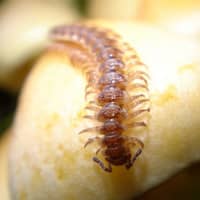
Centipedes

While centipedes are commonly called hundred-leggers because of their numerous legs, they actually only have between 75-150 legs depending on the species. Centipedes are predatory insects and help to control insect populations. Inside of homes though they are considered to be a nuisance. Very fast-moving, they are active at night hunting. During the day they hide out in dark, moist areas, like under loose bark, rocks, porches, decks, and in rotting logs. Centipedes are venomous, using their venom to attack their prey and as a defense mechanism. Centipedes can and will bite humans if threatened. Their bite is very painful: however, the venom, except in very rare cases, is not dangerous to people.
Centipede Identification
Adult centipedes have segmented bodies with a pair of legs per segment. They range in length from 1/8 to 6 inches in length. They have a wormlike body shape and are yellow to dark brown in color and sometimes have stripes or other markings on them. They also have segmented antennae and can either have eyes or no eyes. Even if eyes are present, they have very poor eyesight and instead rely on touch and smell.
Life Cycle & Habits Of Centipedes
Some centipedes can survive anywhere from 1 to 6 years depending on where they are living. Centipedes lay their eggs in the soil, or in hollow rotting logs during the summer months. During the winter they remain dormant. Females can produce up to 35 eggs per reproductive cycle. She will often curl around the eggs and protect them until they hatch. Young centipedes have very few pairs of legs. They will gain more body segments and legs each time they molt.
Centipedes like to live in moist areas, but when there are heavy rains and the ground becomes too saturated with water they will move indoors. They will enter into basements through cracks in the foundation or siding. They are also seen in other parts of houses, especially areas of high moisture.

Trust Massachusetts' oldest family owned pest control company to protect your family & home.